Three-dimensional art begins with prehistoric sculpture. The earliest known Stone Age works are the Venus Berehat Ram and the Venus Tan-Tan, both primitive, dating back to 230,000 BC. After that, sculptors have been active in all ancient civilizations and in all major artistic movements up to the present. After Egyptian sculpture, the major golden ages in the evolution of sculpture were Classical Antiquity (500-27 BC); the Gothic Era (c.1150-1300); the Italian Renaissance (1400-1600); and Baroque sculpture (1600-1700).
Theory of Sculpture.
Because of its three-dimensional nature and the fact that it can be displayed in many other types of locations than, say, painting, there are a number of important concepts and theoretical issues that guide the design and purpose of sculpture.
Elements of sculptural design
The two main elements of sculpture are mass and space. Mass refers to the volume of the sculpture, the solid piece enclosed within its surface. Space is the air around the solid sculpture, and it reacts with the latter in several ways: first, it defines the edges of the sculpture; second, it can be surrounded by part of the sculpture, forming depressions or areas of emptiness; third, it can bind individual parts of the sculpture, which are thus connected to each other in space.
Works of sculpture can be evaluated and differentiated according to their treatment of these two elements. For example, some sculptors focus on the solid component of their sculpture, while others are more concerned with how it relates to the space in which it is located (e.g., how it “moves through” the space or how it surrounds it).
Another important element of (most) sculptures are their surfaces. They can create completely different visual effects depending on whether they are (for example) convex or concave, flat or modeled, colored or unpainted. For example, convex surfaces express contentment, satiety, internal pressure and general “fullness,” while concave surfaces suggest external pressure, internal insolvency and possible collapse. On the other hand, a flat surface carries no three-dimensionality, while a simulated surface – one that contains light/shadowy protrusions or hollows – can convey strong effects of three-dimensional shapes emerging or receding into darkness, similar to the use of Chiaroscuro artists.
